Home » Articles posted by Tessa Sanderson (Page 14)
Author Archives: Tessa Sanderson
Risk Management: Construction Safety & QA | Limit Disputes

By nature, construction a dangerous occupation, the #1 most dangerous across all industries in fact, according to the Bureau of Labor statistics; tragically, in 2019 alone, for instance, 1,061 construction workers died on the job. According to the Occupational Safety and Health Administration (OSHA), 1 in 5 deaths among U.S. workers occur in the construction industry.
![]()
Did you miss our previous article…
https://constructionosa.org/?p=572
ONGC Recruitment for GTs in Engineering & Geoscience disciplines | 309 Posts | 01-11-2021

ONGC Recruitment for GTs in Engineering & Geoscience disciplines with 309 Posts vacancies, last date to apply 01-11-2021
The post ONGC Recruitment for GTs in Engineering & Geoscience disciplines | 309 Posts | 01-11-2021 appeared first on ConstructionPlacements.
Did you miss our previous article…
https://constructionosa.org/?p=569
Reduce Errors in the Field with CM Labs, Trimble Earthworks Excavator Simulator Integration

Pay big money for a project design only to have it be used incorrectly in the field? A new partnership between CM Labs and Trimble aims to provide operators with realistic training on grade control technology.
Launched at The Utility Expo in Louisville, Kentucky, the excavator simulation integration allows training organizations to provide operators of all experience levels access to technology on the modern job site.
The Trimble Earthworks for Excavators software works in parallel with CM Lab’s Vortex Studio software and runs on a tablet, which the user can connect to the simulator. Visual aids are overlaid onto the existing ground along with cut/fill information, slope data and other customizable reference points to provide the user with a better understanding of the work that needs to be done.
“To a user, this will look exactly like the Trimble application, but it’s going to be fed by what they’re doing in the simulation,” said Yannick Lefebvre, technical sales manager, CM Labs. “They can go into Earthworks, program the depth that they want to work at, and know when they are going over a hidden utility line – all of that comes into play.”
A variety of configurable views makes it easier to obtain the right perspective for maximum training value. The integration allows users to get familiar with technology without making costly errors in the field. “We’d like you to make the mistakes here. We’d like you to play with the design here,” said Gary James, training instructor/SimGuide specialist, CM Labs. “When you go to a job site, you’re ready to go. You understand exactly how to build a design, follow a map and customize offsets.”
But training isn’t the only use for the simulators. The system can also serve as a company’s first line of defense against bad hires. “It’s the fake it until you make it world we’re trying to get rid of,” said James. “We want guys and girls to go home at the end of the night. The money is not worth anybody’s life. It’s all about safety.”
Trimble Earthworks is available as an add-on with CM Labs’ Excavator Training Pack and will be expanded to other earthmoving modules. The software is compatible with all of CM Labs’ Vortex Simulators.
Did you miss our previous article…
https://constructionosa.org/?p=566
Even Tighter Supply Coming? Deere Workers Strike For the First Time Since 1986
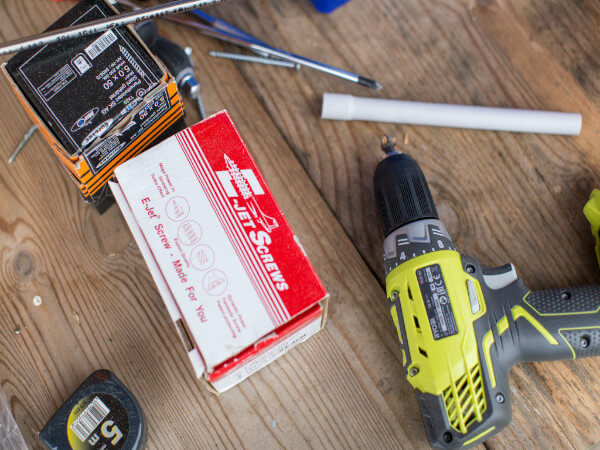
The industry’s inventory woes may have gotten even more pronounced as Deere & Company’s 10,000 UAW workers declared a strike at midnight Oct. 14th.
It is the first major strike at the company since 1986, says The Courier, based in Waterloo, Iowa, where Deere has several plants including its agricultural tractor and engine works. About 90% of UAW members rejected Deere’s latest offer on Oct. 10th. (UAW provided its members with outlined contract changes on Oct. 7th, shown here.) The 1986 strike lasted more than 5 months.
“Our members at John Deere strike for the ability to earn a decent living, retire with dignity and establish fair work rules,” says Chuck Browning, vice president and director of the International Union, United Automobile, Aerospace and Agricultural Implement Workers of America’s (UAW) Agricultural Implement Department. “We stay committed to bargaining until our members’ goals are achieved.”
“John Deere is committed to a favorable outcome for our employees, our communities and everyone involved,” says Brad Morris, Deere’s vice president for labor relations. “We are determined to reach an agreement with the UAW that would put every employee in a better economic position and continue to make them the highest paid employees in the agriculture and construction industries.”
Morris adds: “We will keep working day and night to understand our employees’ priorities and resolve this strike, while also keeping our operations running for the benefit of all those we serve.”
good time to strike?
Unions know they are in a good position to press for favorable changes in today’s tight labor market and in the face of increasing demand.
In its Q3 earnings report, John Stone, president of Deere’s Construction & Forestry Division said, “Demand for earthmoving and compact construction equipment will exceed our production for the year, resulting in low inventory levels as we exit the fiscal year,”
UAW President Ray Curry notes that “UAW John Deere members have worked through the pandemic after the company deemed them essential, to produce the equipment that feeds America, builds America and powers the American economy. These essential UAW workers are showing us all that through the power of a strong united union voice on the picket line they can make a difference for working families here and throughout the country.”
Picket lines have been set up outside Deere plants in Iowa, Illinois and Kansas. Deere says it has activated its “Customer Service Continuation Plan,” in which “employees and others will be entering our factories daily to keep our operations running. Our immediate concern is meeting the needs of our customers, who work in time-sensitive and critical industries such as agriculture and construction.”
The Courier says Deere’s six-year offer would have raised wages by 20% over the life of the contract and also increased some benefits. The Dubuque Telegraph-Herald, where the company’s massive Dubuque Works is located, reported that Deere’s offer would have raised a typical production employees salary from $33 an hour to nearly $40 an hour over the six-year contract.
Other OEMs likely are paying close attention to strike outcome. CNH Industrial and UAW negotiated their current six-year agreement in 2016. The current Caterpillar/UAW contract runs through 2023.
Did you miss our previous article…
https://constructionosa.org/?p=563
Locating Issues a Persistent Cause of Utility Damages

Underground utilities were damaged in an estimated 468,000 excavation-related incidents in 2020, according to the DIRT Report released last month by the Common Ground Alliance (CGA). Despite those numbers being down 12% from 2019, the industry shouldn’t pat itself on the back quite yet.
CGA says the decline in damages coincides with a 4.2% dip in construction activity during the pandemic. The overall emphasis on safety because of the global pandemic may have led to less crowded and potentially less distracting jobsites.
No locate request and poor locating practices were tied at 32%, respectively, causing 64% of the reported damages that have known root causes. Those include failure to notify 811 and facilities not marked or marked inaccurately due to locator error or the presence of an abandoned facility.
Rounding out the “big three,” poor excavation practices was the next highest cause, at 30%. Digging before verifying marks by a test hole combined with a failure to maintain clearance were the most consistent causes of damages in the field.
The pandemic triggered a steep rise in homeowner locate requests and digging activities associated with home improvement projects, whether by homeowners or professional contractors. Despite the increase in homeowner activity, damages involving occupants did not increase.
While estimated damages in the U.S. decreased in 2020, the report shows a five-year trend in damage rates that has plateaued. The 2020 DIRT Report predicts the next few years will bring an increase in construction activity and the potential of a national infrastructure program that will require the damage-prevention industry to focus on addressing the consistent rate of damages and estimated $30 billion in societal costs incurred as a result of damages to buried infrastructure each year.
The most commonly damaged utility lines were telecommunications at 50%, natural gas at 23% and cable TV at 11%.
The report also found:
June was the month with the most total damages in 2020. Wednesday was the most common day of the week that damages occurred.Backhoes topped the list of known equipment-caused damages at 15%.
“The DIRT Report is a crucial tool for understanding the most pressing challenges in damage prevention – and to truly make progress on addressing the handful of damage root causes that are driving the vast majority of damages,” said Sarah K. Magruder Lyle, president and CEO of CGA.
“With the potential of significant infrastructure legislation becoming law coupled with an expected increase in construction activity in the coming years, we must focus on the challenges outlined in the DIRT Report and work together as an industry to improve each step of the damage-prevention process.”
CGA is a nonprofit association of the underground utility industry that seeks to prevent damage to North American underground infrastructure by promoting damage-prevention practices.
Did you miss our previous article…
https://constructionosa.org/?p=560
JCB Unveils Its Tallest Telehandler, the Rotating 512-83R
JCB is going bigger and taller with its new eight-story-high rotating telehandler, the 512-83R, which it calls three machines in one.
JCB says it can also serve as a crane or be equipped as an aerial work platform.
The telehandler has a max lift height of 83 feet and a max lift capacity of 12,000 pounds.
The company designed the machine for the changing jobsite in which larger loads need to be lifted to greater heights. JCB has modular home and building construction in mind for the 512-83R, but also says it can be used for any construction site dealing with suspended loads. It is also designed for the rental market, with simple, intuitive controls, and can be used for infrastructure projects, such as bridge work, or in urban areas with little space.
“It’s perfect for lifting and placing materials, panels and modular components at height in a very safe way and in a very productive manner,” said Tim Burnhope, JCB chief innovation and growth officer.
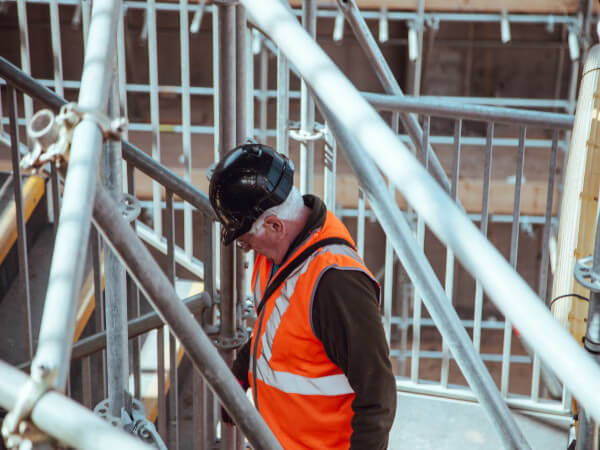
The JCB 512-83R rotating telehandler can also serve as an aerial work platform.JCBThe telehandler delivers continuous 360-degree rotation and is designed for fast setup, as its outriggsers can be automatically extended in 26 seconds and retracted. “Unlike the mobile crane, the [512-83R] can be set up on the site rapidly with outriggers that can be deployed, stored and leveled at the touch of a button,” Burnhope said during the product’s online unveiling.
The telehandler can also be operated by remote control.
Available attachments include pallet forks, rotating forks, winches, a lifting hook and a light-duty bucket. The attachments use radio-frequency identification, or RFID, so the correct load chart for the tool automatically pops up on the telehandler’s 7-inch screen.
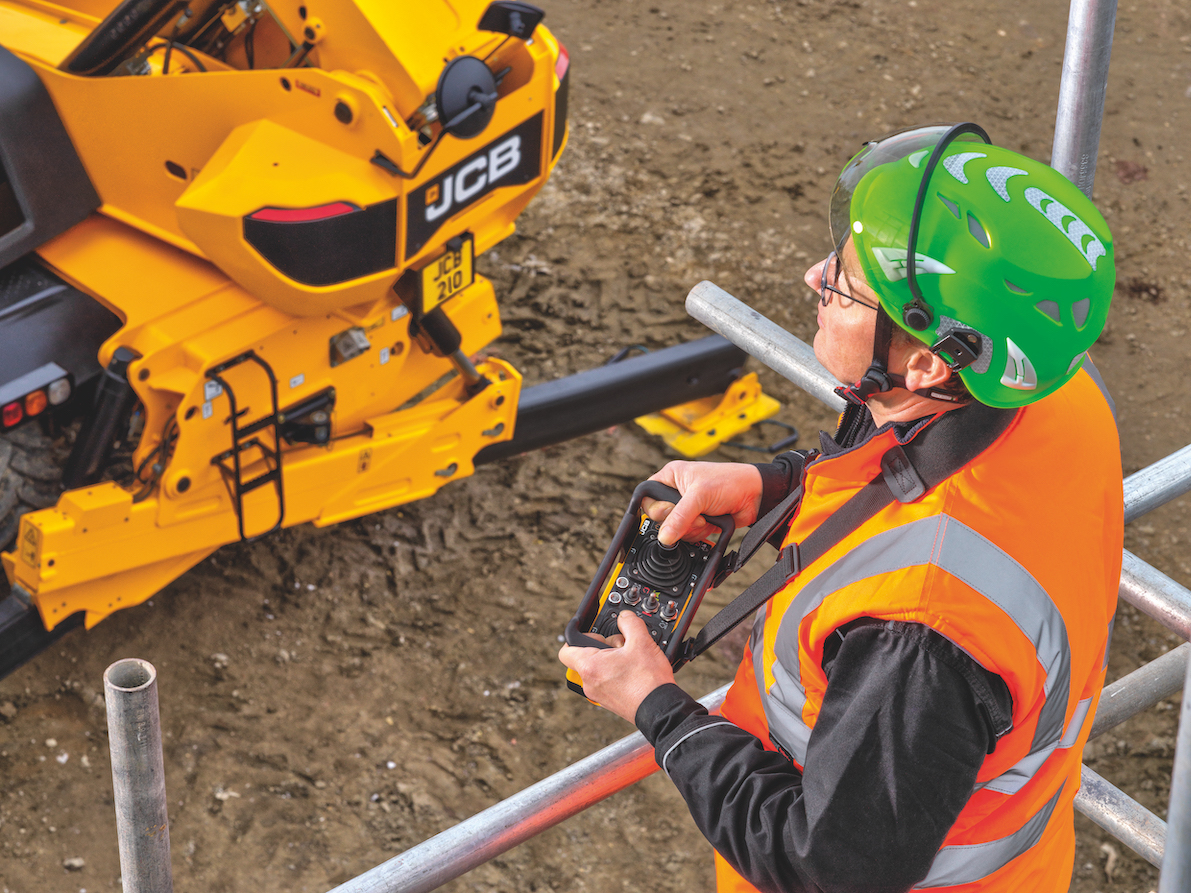
The JCB 512-83R rotating telehandler can be operated by remote control.JCBThe four-section boom with one telescopic cylinder has a low profile for better operator visibility. A camera can be mounted to its head, so the operator can see better when placing loads at height. The boom can lift up to 4,400 pounds to max height and up to 660 pounds at full horizontal reach, which is 70 feet.
The telehandler runs on a 145-horsepower JCB EcoMax diesel engine and a two-speed hydrostatic transmission. It can travel up to 25 mph and has three steering modes. Turning radius is under 10 feet. Four-wheel drive is available for off-road work.
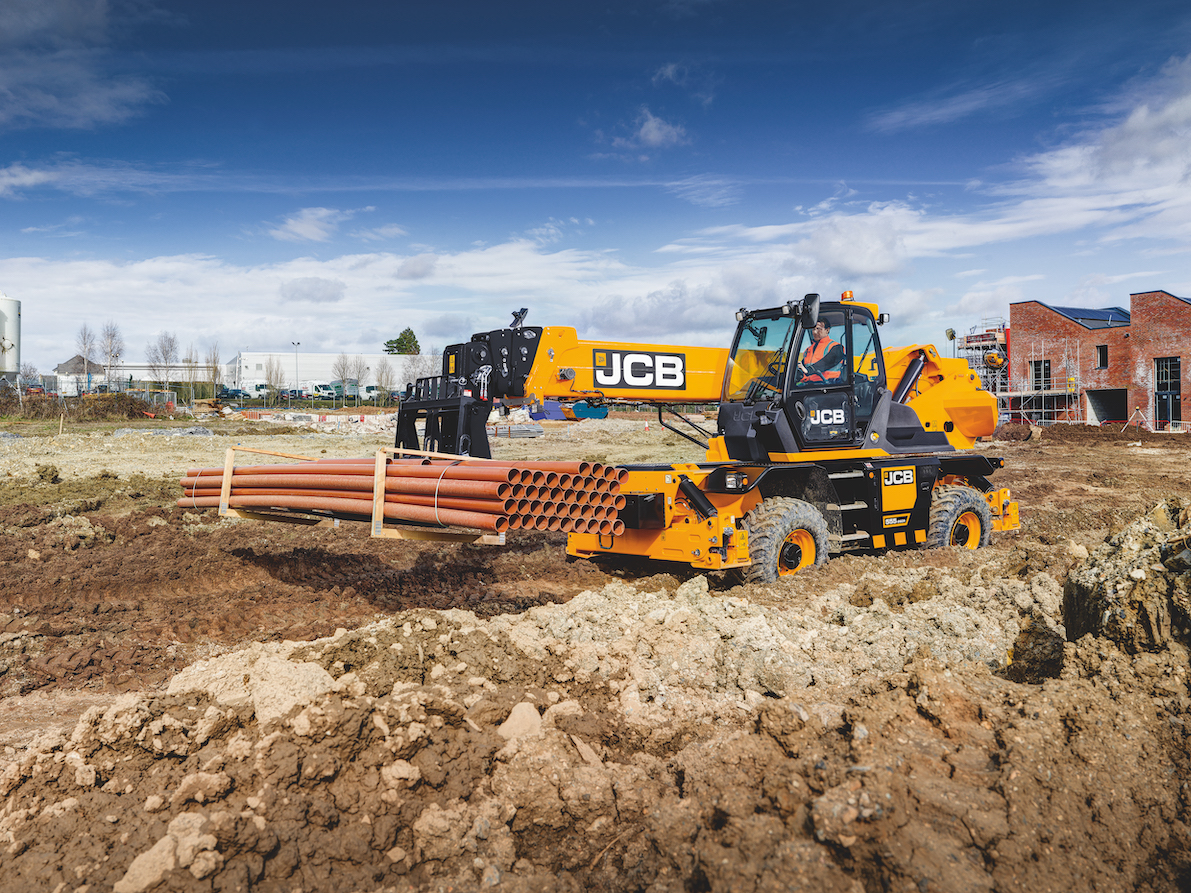
JCB 512-83R rotating telehandlerJCBThe engine and the machine’s service points have been placed at ground level for easy access. Service intervals are at 500 hours. Seating options are available for the cab. Work lights and camera kits are optional. A five-year subscription to JCB LiveLink telematics is standard.
JCB says it is currently taking orders for the 512-83R.

JCB 512-83R rotating telehandlerJCB
Did you miss our previous article…
https://constructionosa.org/?p=554
Report: One-Fourth of Infrastructure Faces Flood Risk. (Here’s How to Check Your Area’s Threat Level.)
A new report estimates that one-fourth of all critical infrastructure in the U.S. is at risk of flooding, and that percentage will increase as storms become more severe due to climate change.
The science and technology nonprofit First Street Foundation, in what it calls “the first ever nationwide community level flood resilience report,” says state and local governments are not equipped to handle the present and future flood risks to critical infrastructure.
“As we saw following the devastation of Hurricane Ida, our nation’s infrastructure is not built to a standard that protects against the level of flood risk we face today, let alone how those risks will grow over the next 30 years as the climate changes,” says Matthew Eby, founder and executive director of First Street Foundation.
The “Infrastructure on the Brink” report says that 25% of current “critical infrastructure,” such as utilities, airports, ports, and emergency services like police, fire and hospitals, is at risk of becoming inoperable due to flooding.
It estimates these other current infrastructure flood risks:
23% of all road segments in the country (nearly 2 million miles of road). 20% of all commercial properties (919,000).17% of all “social infrastructure” facilities (72,000). This includes such properties as schools and government buildings.14% of all residential properties (12.4 million).
The risks are expected to increase through 2051.
“Over the next 30 years, due to the impacts of climate change, an additional 1.2 million residential properties, 66,000 commercial properties, 63,000 miles of roads, 6,100 pieces of social infrastructure and 2,000 pieces of critical infrastructure will also have flood risk that would render them inoperable, inaccessible or impassable,” the report says.

This chart shows the expected increase in flood risks by infrastructure category over the next 30 years.First Street Foundation’s “Infrastructure on the Brink” report
The report shows these four states facing the highest concentration of current risk: Louisiana, Florida, Kentucky and West Virginia. Of the top-20 at-risk counties in the U.S., 17 are in these four states.
The report also provides data on all at-risk cities and counties, and you can search on First Street’s website to find the flood risk for your property with the nonprofit’s free FloodFactor tool.
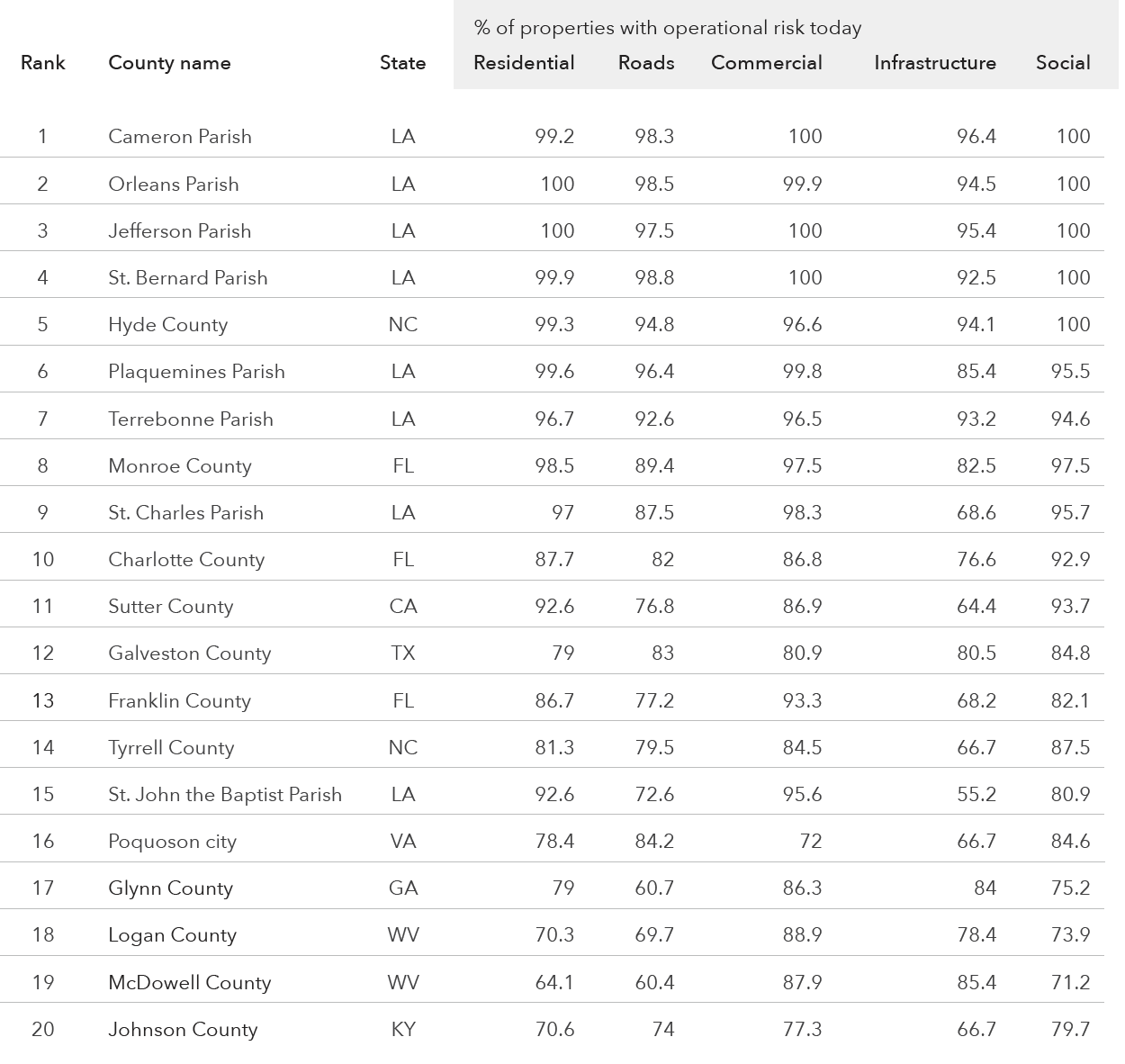
This chart shows the top-20 counties most at-risk to physical infrastructure flooding and the percentages of their infrastructure categories that are at risk. (Note: The “Infrastructure” column represents “critical infrastructure,” such as airports, fire stations, hospitals, police stations, ports, power stations.)First Street Foundation’s “Infrastructure on the Brink” report
For cities facing the most flood risk today, Moliere and New Orleans, Louisiana, top the rankings, with most, if not all, of their infrastructure vulnerable. Cities in California, South Carolina, Florida and Alabama also made the list.
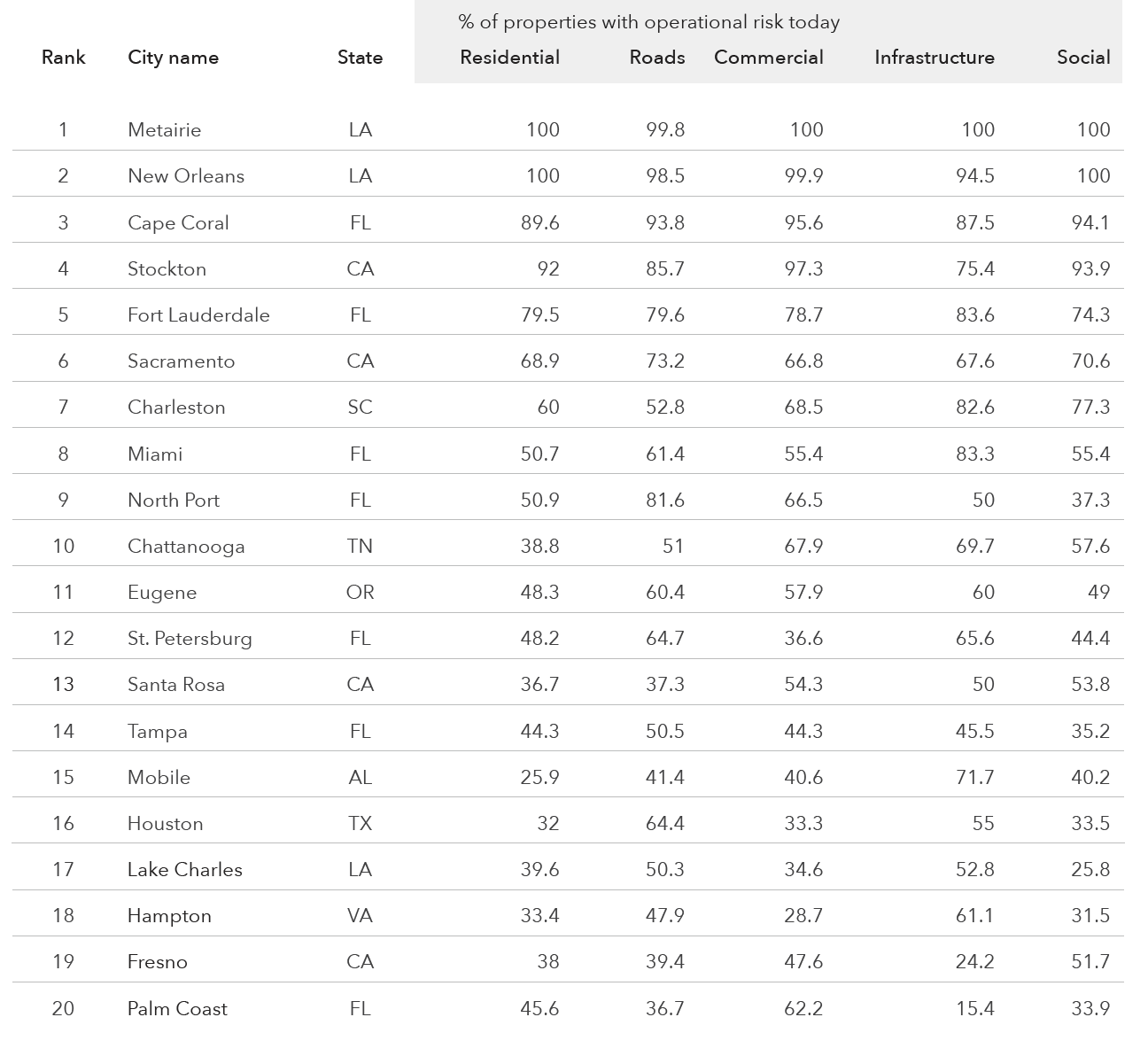
This chart shows the top-20 cities most at-risk to physical infrastructure flooding and the percentages of their infrastructure categories that are at risk. (Note: The “Infrastructure” column represents “critical infrastructure,” such as airports, fire stations, hospitals, police stations, ports, power stations.)First Street Foundation’s “Infrastructure on the Brink” report
The report also looks into the future, showing which counties will see the largest percentage increase in infrastructure risk by 2051. Virginia has several metro areas facing a significantly increased threat. The list also includes counties in North Carolina, Massachusetts, Maryland and Texas.
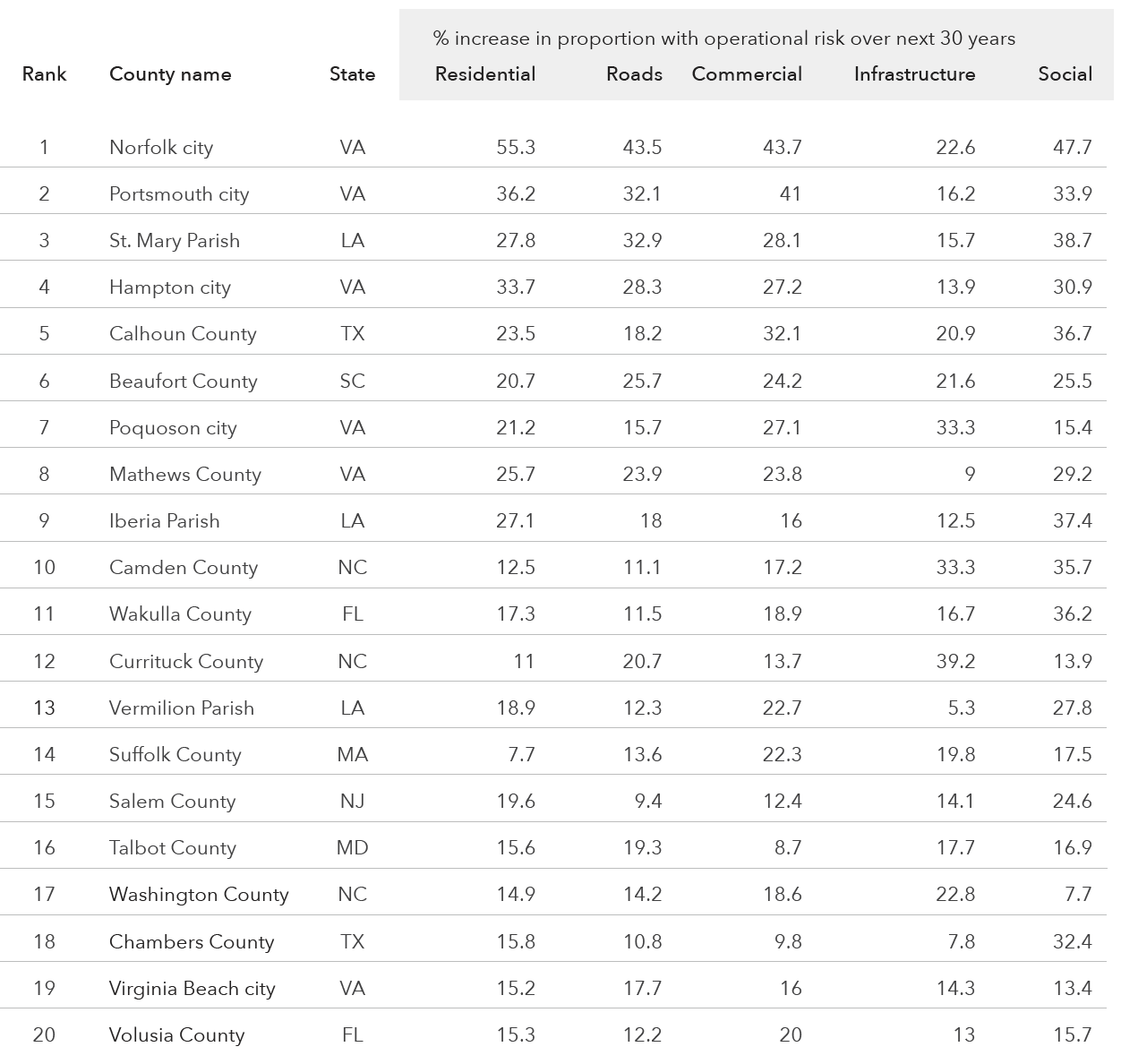
This chart shows the top-20 counties with the highest estimated percentage increase of risk to physical infrastructure flooding by 2051 and the percentages of their infrastructure categories that are at risk. (Note: The “Infrastructure” column represents “critical infrastructure,” such as airports, fire stations, hospitals, police stations, ports, power stations.)First Street Foundation’s “Infrastructure on the Brink” report
The report says the impact of the increased risks could devastate local communities. It notes that in Harris County, Texas, home to Houston, 770 hospitals, public utilities and water-treatment plants currently risk becoming inoperable due to flooding this year.
Miami-Dade, Florida, has 1,640 schools, churches and museums at risk. The Chicago metro area has 225,000 residential properties at risk. And in the New Orleans area, 99% of the roads are at risk of becoming undrivable because of flooding, the report says.
First Street Foundation hopes the data will help prioritize funding toward protecting infrastructure from flood risks.
“Our work aims to determine the amount of flooding that would render infrastructure either inoperable or inaccessible,” says Dr. Jeremy Porter of First Street Foundation. “By applying research on depth thresholds and comparing them to flood data and probability metrics, we can determine roughly the extent of flooding that would cause a road to be impassable to cars, or a hospital to be shut down.”
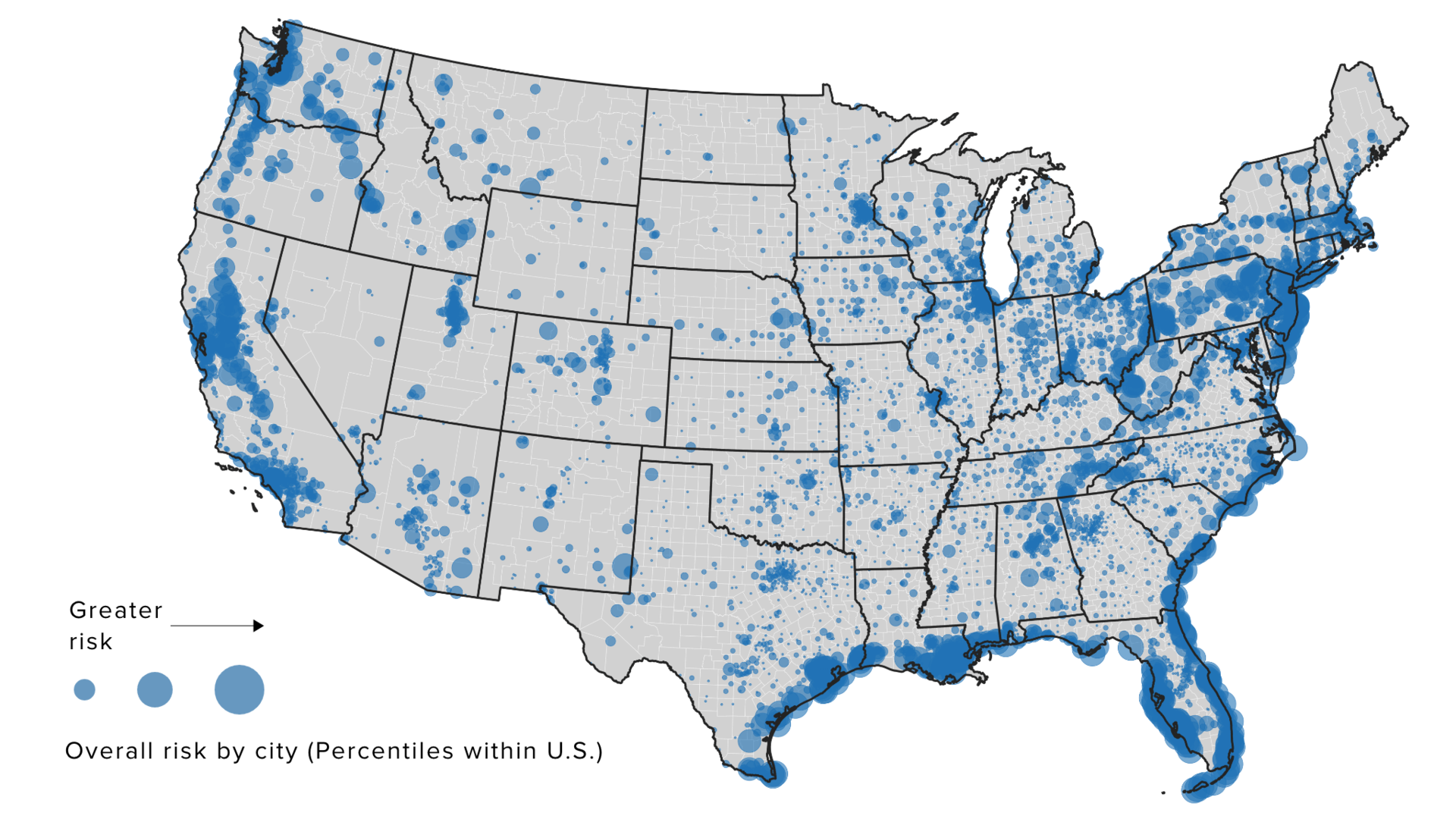
This map shows where the greatest flood risks are to infrastructure.First Street Foundation’s “Infrastructure on the Brink” report
Prinoth Purchases Jarraff Industries, Expands Reach into Right-of-Way Maintenance Market
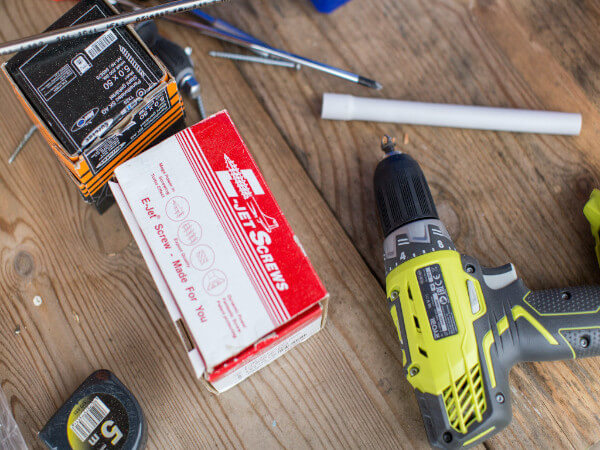
Prinoth has purchased 100 percent of the capital stock of Jarraff Industries, a Minnesota-based manufacturer of right-of-way maintenance equipment. The acquisition will further increase Prinoth’s presence in the U.S. and expand its offering in the specialized off-road equipment segment. The agreement was effective October 1.
“I am very proud of the legacy we have established and nurtured over the past 42 years,” said Heidi Boyum, president, Jarraff Industries. As a family-run and -owned business, I view today’s transaction as an opportunity to ensure that the business, customers, employees, and the community we are in continue growing while joining an even larger family.”
Boyum will continue to work as a strategic advisor to Jarraff Industries and PRINOTH. Jarraff’s COO Steve VanRoekel will remain as the Chief Operating Officer.
Prinoth Group President Klaus Tonhäuser said Prinoth was interested in Jarraff’s products for utilities right of way and maintenance, a segment that is in high demand.
“Jarraff’s specialized product portfolio and strong presence in these critical market segments will provide our customers access to industry-leading products backed by our brand, distribution, and manufacturing experience,” Tonhäuser said in a news release.
PRINOTH is a manufacturer of snow groomers, tracked vehicles and vegetation management vehicles and equipment.
Did you miss our previous article…
https://constructionosa.org/?p=543
Industry Roundup: H&E Opens 3rd Utah Branch
H&E Equipment Services has opened a new rental branch just north of Salt Lake City in Ogden. It is the company’s third Utah facility.
The 8,500-square-foot facility sits on three acres and features a fenced yard, offices, parts warehouse and separate repair shot with six service bays. The facility will offer construction and general industrial equipment for customers in northern Utah, southeast Idaho and western Wyoming.
Chris Baron, who also leads the company’s Salt Lake City branch, will manage the location.
Kirby-Smith names Kunin VP, adds Atlas

Kirby-Smith Machinery (KSM) has named Mike Kunin vice president of national accounts, following the promotion of John Arapidis to president and CEO.
Kunin will oversee the management and continued development of strategic partnerships between the company and its national account customers. He comes to the dealership after having held several key positions at Komatsu America during the past 21 years, including parts sales, construction and support equipment and most recently as business director of Komatsu’s central region. He will be located in KSM’s headquarters in Oklahoma City.
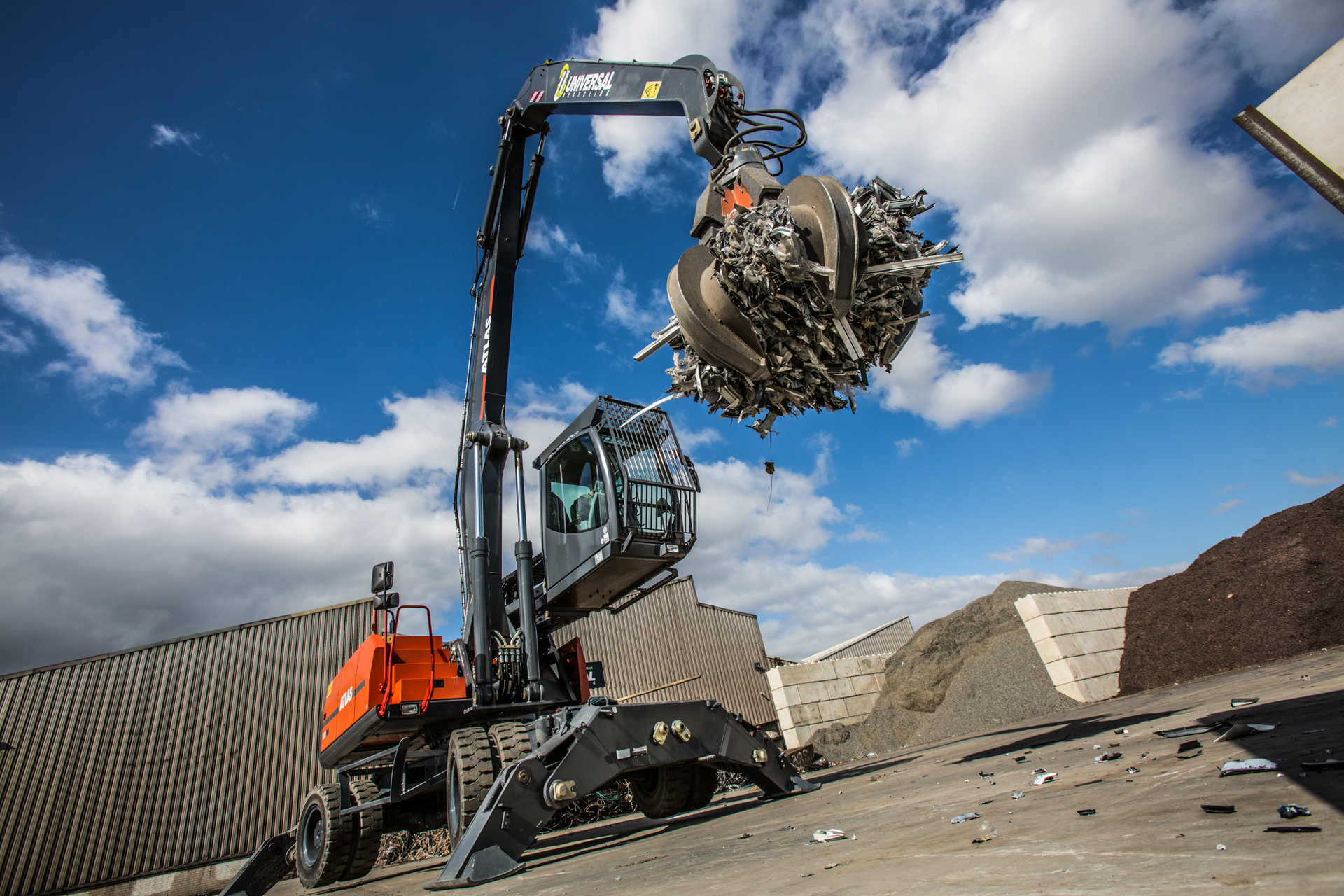
SMH GroupKMS has also added the SMH Group US’s line of Atlas material handlers and will represented the line in Oklahoma, Kansas, Missouri and Illinois. The Atlas line includes mobile industrial and industrial tracked machines for the scrap, wood and recycling markets, among others.
KMS has 12 branch locations in Oklahoma, Texas, Kansas and Missouri.
W.W. Williams relocates Charleston store
W.W. Williams Company’s Charleston, South Carolina, branch has moved to a new location. The 20,000-square-foot facility has 14 service bays for repairing and servicing medium- and heavy-duty trucks, fleets, construction equipment, emergency vehicles and marine vessels in addition to power generation sales and service.
Maverick Environmental adds Morbark line
Maverick Environmental Equipment has become a Morbark Industrial Products dealer for Ohio, Indiana, Kentucky ad western West Virginia. The company will sell and service Morbark’s line of tree care, forestry, sawmill and wood recycling equipment.
Herc buys Rapid Equipment Rental
Herc Holdings, parent of Herc Rental, has bought Toronto-based Rapid Equipment Rental. Rapid Equipment Rental currently has 110 employees and seven locations. Founded in 2013, it serves the industrial and construction markets in Toronto and the surrounding areas.
Herc says the acquisition supports its long-term strategy to achieve greater density and scale in select urban markets across North America. It currently has 295 locations in North America.
MANUFACTURERS
Bomag adds milling, paving VP
Bomag Americas has named Chris Colwell its vice president of milling and paving, responsible for overseeing the company’s new business unit segment. Colwell’s industry experience includes positions with Astec Industries, Carlson Paving Products and managing a road construction equipment dealership.
Generac expands in Wisconsin
Generac has announced it will invest $53 million in facilities across the state over the next three years, creating more than 700 jobs. Expansion plans include a new administrative and R&D facility in Pewaukee, announced in July. The company’s global headquarters will remain in Waukesha, Wisconsin.
Did you miss our previous article…
https://constructionosa.org/?p=539
Thunder Creek’s Intros Service and Lube Upfit for Medium-Duty Trucks, No CDL or HAZMAT Required

Thunder Creek Equipment’s new Service and Lube Upfit (SLU) for medium-duty truck bodies doesn’t require drivers to have CDL or HAZMAT certifications, saving customers from increased insurance costs, and the cost of hiring highly sought after CDL drivers.
The new product, launched at The Utility Expo in Louisville, Kentucky, allows for customization much like the company’s Service and Lube Trailer, but with the nimbleness of a medium-duty service body.
Smaller than a traditional service and lube truck, the SLU can be installed on a Ford F-550 or Ram 5500 chassis. “Dealers, rental companies and construction companies are having a hard time hiring technicians and CDL drivers. Plus, they’re finding out they’re not being profitable sending out a $300,000 truck with a $40-an-hour employee to do a simple oil change,” said Steven Ile, territory sales manager, Thunder Creek Equipment. “This affords them the ability to put anybody with a valid driver’s license and basic technical skills in the truck and go.”
A built-in VMAC air compressor powers the entire SLU pneumatic pumping system. The tanks provide a total capacity of 690 gallons and are configurable in 115-, 55-, and 25-gallon tanks, depending on a customer’s fleet maintenance needs.
Fluids supported include fresh oil, reclaimed oil, grease, antifreeze, reclaimed antifreeze, high flow oil, diesel fuel and diesel exhaust fluid. “It is 100 percent customizable,” said Ile. “If one customer needs 345 gallons of fresh oil and 345 gallons of waste oil because they’re only changing oil, we can do that. If the next customer is running Deere, CAT and Komatsu equipment and needs three different spec oils, we can break that up into multiple tanks and give them more fluids.”
All fluid maintenance systems are plumbed into the truck’s new Utility Box, which features a streamlined control panel. The control panel is color coded to match the nozzles and hoses, making it easy to use for operators and reduce training. The SLU also features ample storage for filters and tools.
Each SLU is built to order. Customers can purchase the Service and Lube Upfit via select dealers or directly from Thunder Creek Equipment.